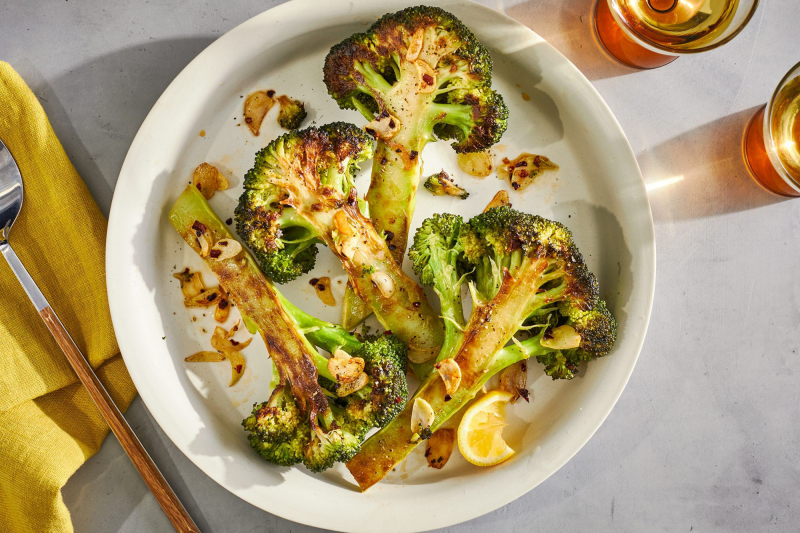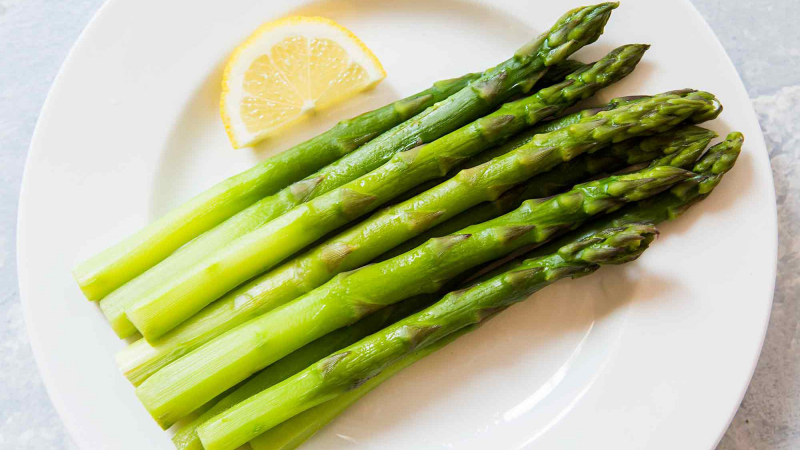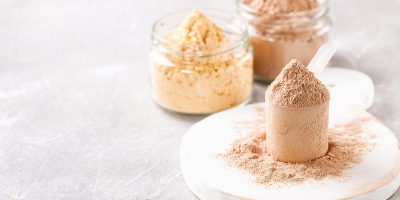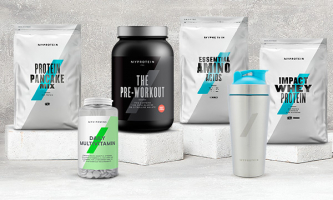Top 10 Best High-Protein Vegetables
The health of your body's structure depends on protein, which is essential for numerous body parts, including your muscles and hair. Although you may already ... read more...be familiar with protein-rich foods like legumes, dairy, meat, poultry, and seafood, did you know that some vegetables also contain a significant amount of protein? This list contains some surprising foods that may surprise you.
-
A cruciferous vegetable that can be consumed both raw or cooked is broccoli. In addition to being high in vitamins and minerals, broccoli also contains a significant amount of protein. Broccoli is higher in protein than most vegetables.
The amount of protein in broccoli, according to the USDA, is as follows:
- 3.7 grams per 1 cup
- 2.4 grams per 100 grams
- 13.6 grams per 200-calorie serving
Additionally, one cup of cooked broccoli has 5.1 grams of fiber and more than the recommended daily amounts of vitamins C and K. Isothiocyanates found in broccoli may lower your risk of cancer and lower a number of disease risk factors. Additionally, this vegetable may improve eye health and decrease cholesterol. Due to their nutritional content and proven health advantages, they are regarded as one of the healthiest vegetables. And broccoli is usually well tolerated, so allergy is rare. It is easy to prepare and edible both raw and cooked.

Broccoli 
Broccoli -
Potatoes include a lot of carbohydrates and have a lot of calories. However, potatoes also offer a variety of nutritional benefits, such as protein. Protein is referred to as the "building block" of all the essential parts of our bodies, including blood, tissue, muscle, and bone.
Per the USDA, Russet potatoes contain the following amounts of protein:
- 4.5 grams per 1 medium potato
- 2.6 grams per 100 grams
- 5.4 grams per 200-calorie serving
According to a study published in Advances in Nutrition, potatoes are also high in vitamins and minerals like vitamin C, fiber, potassium, and vitamin B6. Though potatoes are rich in many nutrients, keep in mind that you may want to combine them with another type of protein, such as meat or beans, for a meal that is well-balanced.

Potatoes 
Potatoes -
Corn is a good option for vegetarians and vegans who want to consume more protein from non-animal sources because it has a greater protein content than many other vegetables. A diet high in protein may help in maintaining a healthy weight by either decreasing appetite or encouraging the body to burn more calories, according to some research.
You might be surprised by the amount of protein you’ll actually get from corn. The following proteins are found in corn, according to the USDA:
- 3.5 grams per 1 medium ear
- 3.4 grams per 100 grams
- 7.1 grams per 200-calorie serving
Corn is an affordable and accessible source of calories, carbohydrates, and protein. Despite technically being a grain, corn is gluten-free. As a result, corn is a safe option for those who want to include grains in their diet but have celiac disease or gluten intolerance.

Sweet Corn 
Sweet Corn - 3.5 grams per 1 medium ear
-
Green peas are tiny, but they contain a lot of vitamins and nutrients, such as folate, thiamin, and vitamin C. They are also among the vegetables with the most variety. Green peas are a legume, so they also have a good amount of protein.
USDA has confirmed that boiling green peas are a great source of protein including:
- 8.6 grams per 1 cup
- 5.4 grams per 100 grams
- 12.8 grams per 200-calorie serving
A study from November 2014 that was published in the journal Applied Physiology, Nutrition, and Metabolism suggested that green peas may offer protection against cancer, inflammation, and cardiovascular disease. The majority of people buy frozen peas because they are convenient to store and defrost quickly, even though fresh peas are also available at farmer's markets and grocery stores because they grow quickly and are among the first vegetables to become available in late spring.

Green Peas 
Green Peas -
It may surprise you how much protein spinach has. It is also rich in vitamins and minerals, such as vitamin K, folate, iron, vitamin A, vitamin C, potassium and magnesium.
The USDA reports that spinach that has been cooked contains the following amount of protein:
- 5.3 grams per 1 cup
- 3 grams per 100 grams
- 25.8 grams per 200-calorie serving
Consider spinach if you want to increase your consumption of vegetables high in protein. It's a heart-healthy food as well as a good source of plant-based protein. According to a small study with just 27 participants that was published in Clinical Nutrition Research in July 2015, spinach has a significant concentration of nitrates, which help to prevent bad cardiovascular events and high blood pressure. According to the study, eating spinach can lower blood pressure.

Spinach 
Spinach -
One of the first vegetables to appear in farmer's markets each spring are the delicious green sprouts of asparagus. They also contain a lot more protein than you'd assume, in addition to a variety of other vitamins and minerals like riboflavin and vitamin K.
The following proteins are found in cooked green asparagus, according to the USDA:
- 4.3 grams per 1 cup
- 2.4 grams per 100 grams
- 21.8 grams per 200-calorie serving
Both fiber and vitamin K are abundant in asparagus. However, green asparagus has a slight advantage in terms of protein content. Although there are many ways to cook asparagus, some of the more popular ones are roasting, sautéing, and grilling. In the grocery store vegetable section, look for asparagus. It tastes better when it is fresher. Pick asparagus that is standing tall, has no limpness in the stalk and is in good condition all the way around the tips.

Green Asparagus 
Green Asparagus -
Brussels sprouts boast high levels of many nutrients and have been linked to several health benefits. Children may find Brussels sprouts to be a fearsome green vegetable, but when steamed, this high-protein vegetable makes for a nutritious and appealing side dish.
According to the USDA, Brussels sprouts have the following protein concentration:
- 4 grams per 1 cup
- 2.6 grams per 100 grams
- 14.2 grams per 200-calorie serving
Not only being a vegetable packed in protein, but Brussels sprouts are also a great source of iron. The increased risk of iron deficiency is one of the drawbacks of being vegan. Brussel sprouts can help you meet your daily iron needs if you eat a plant-based diet. Most grocery stores have Brussels sprouts all year long in the fresh produce section. Avoid picking any Brussels sprouts that are fading or turning yellow. Instead, opt for Brussels sprouts that are bright green and firm to the touch.

Brussels Sprouts 
Brussels Sprouts -
Although they are sometimes considered vegetables, mushrooms are actually fungi. Mushrooms, like many other vegetables, can be consumed either cooked or raw. They provide a great substitution for beef or vegetarian burgers due to their patty shape.
According to the USDA, grilled portabella mushrooms are a great source of protein:
- 4 grams per 1 cup
- 3.3 grams per 100 grams
- 22.6 grams per 200-calorie serving
They may mitigate the risk of developing serious health conditions, such as Alzheimer’s, heart disease, cancer, and diabetes. White mushrooms are the most protein-dense mushrooms on a per calorie basis, while oyster mushrooms have the most protein on a per weight basis. In almost every grocery or health food shop, mushrooms can be found in the produce section. It is not advised to collect them from the wild because many mushroom types are toxic and difficult to identify from edible varieties.

Mushrooms 
Mushrooms -
Grilled artichokes are more than simply a snack; they now rank among the vegetables high in protein. Though they are abundant in fiber, artichokes are also a low-calorie and low-carb vegetable. Artichokes are a low-calorie source of protein that can be consumed if your fitness goal is weight loss.
According to the USDA, there are the following amounts of protein in cooked artichokes:
- 4.8 grams per 1 cup
- 2.9 grams per 100 grams
- 11.3 grams per 200-calorie serving
- 3.5 grams per 1 medium artichoke
Artichoke preparation and cooking are not as difficult as they seem. They may be sautéed, grilled, steamed, boiled, or roasted. In order to give them an extra flavor boost, you may also prepare them grilled or stuffed. The most common cooking method, steaming, often takes 20 to 40 minutes, depending on the size. Artichokes can also be baked for 40 minutes at 350°F (177°C). Remember that you can eat the leaves and the heart.

Artichokes 
Artichokes -
Sweet potatoes are root vegetables rich in protein and other nutrients, which is why bodybuilders and professional athletes frequently use them in their diets. Just one sweet potato gives you 400% of the vitamin A you need each day.
The USDA confirms the high protein content of cooked sweet potatoes:
- 4 grams per 1 cup
- 2 grams per 100 grams
- 4.5 grams per 200-calorie serving
Both orange and purple sweet potatoes are renowned for their nutritional value and health advantages. Researchers discovered that purple sweet potatoes had powerful antioxidant and prebiotic properties in a March 2018 study that was published in Scientific Reports. With their prebiotic-like activity and ability to inhibit harmful bacteria in the microbiome, they can have an impact on gut health.

Sweet Potatoes 
Sweet Potatoes































